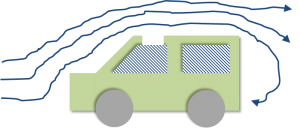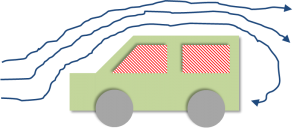My apologies in advance if you’ve never had the privilege to ride in a car with a sun roof at a high rate of speed. If you’ve been this fortunate, perhaps, because sun roofs can be quite noisy when traveling at high rates of speed, you’ve been in such a car during which the sun roof is closed while traveling at a high rate of speed. If not, I think closing a window while the car is moving fast can work equally well.
I bring this up, because it happened to me this weekend, and I noticed something quite interesting, which aroused the fluid dynamicist in me. My ears popped. Like changing elevation quickly, or closing your nose off while blowing out, the pressure in my ears changed. This caught me off guard, but it should not really come as a surprise.
Engineers use a similar principle to determine pressure drops in pipes, using an instrument called a manometer. It all starts with the Bernoulli equation: +\rho g z_2
Bear with me, but we’ll go ahead and ignore the effect of elevation in this case, leaving us:
A manometer can measure the static pressure of a flow (the p value in the above equation) with an opening perpendicular to the direction of flow. Oftentimes, whatever tube that’s perpendicular to the flow will have a column of liquid that will move up or down depending on the static pressure it is measuring.
Okay, so let’s call the car a giant manometer of sorts that takes on the static pressure of the air whooshing by the sun roof. Supposing the static pressure of the air rushing by is simply a single atmosphere (101 kPa), then if there was no other circulation in and out of the car, this is what the static pressure of the car would be (the caveat is that the geometry of the sun roof is probably not ideal for measuring the precise static pressure).
 |
 |
Well, if the car were perfectly sealed, and the sun roof could close very, very fast, the pressure would not change. However, the car is certainly not immune from the influences of the outside air, even with the sun roof close. I’m going to assume that with all the windows closed and the A/C off, the inside of the car will equilibrate to the stagnation pressure:
That doesn’t seem like a huge difference, but it’s likely sufficient for your ears to pick up on. If the A/C was on high or there was a giant hole in your windshield, the car would probably maintain a pressure of 101.4 kPa. But suppose the forces driving the pressure of the car down to 101 kPa through the sun roof are more powerful than the ventilation leaks that would tend to move the needle to 101.4 kPa. Then the act of closing the sun roof will quickly (depending on how “leaky” the car is) shift the pressure up to 101.4 kPa, causing your ears to pop!
My intention was to come up with a cleaner description for this effect than I managed to churn out. My apologies for making a mess of it, and I’m open to suggestions on how to tighten up the explanation… but it’s a simple enough experiment to try it out for yourself!

